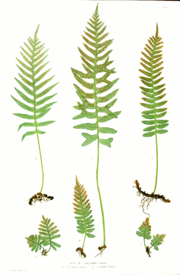
The Ferns of Great Britain and Ireland
Encyclopedia

Nature printing
Nature printing is a printing process, developed in the 18th century, that uses the plants, animals, rocks and other natural subjects to produce an image...
by Henry Bradbury
Henry Bradbury
Henry Bradbury is best known for his book The Ferns of Great Britain and Ireland with author Thomas Moore and editor John Lindley published in 1855 and using the new technique of nature printing invented by Alois Auer and Andreas Worring in 1852 and improved by Bradbury...
.
Description
The text was a scientific description of all the varieties of FernFern
A fern is any one of a group of about 12,000 species of plants belonging to the botanical group known as Pteridophyta. Unlike mosses, they have xylem and phloem . They have stems, leaves, and roots like other vascular plants...
s found in the British Isles
British Isles
The British Isles are a group of islands off the northwest coast of continental Europe that include the islands of Great Britain and Ireland and over six thousand smaller isles. There are two sovereign states located on the islands: the United Kingdom of Great Britain and Northern Ireland and...
. The author of this work was the botanist Thomas Moore
Thomas Moore (botanist)
Thomas Moore was a gardener and botanist from the United Kingdom of Great Britain and Ireland. An expert on ferns and fern allies from the British Isles, he served as Curator of the Society of Apothecaries Garden from 1848 to 1887...
, the editor was John Lindley
John Lindley
John Lindley FRS was an English botanist, gardener and orchidologist.-Early years:Born in Catton, near Norwich, England, John Lindley was one of four children of George and Mary Lindley. George Lindley was a nurseryman and pomologist and ran a commercial nursery garden...
.
The book was released at a time of so-called "pteridomania
Pteridomania
Pteridomania or Fern-Fever was a craze for ferns. Victorian decorative arts presented the fern motif in pottery, glass, metal, textiles, wood, printed paper, and sculpture, with ferns "appearing on everything from christening presents to gravestones and memorials."-Description:Pteridomania, meaning...
" in Britain. Along with William Grosart Johnstone's The Nature-Printed British Seaweeds (London, 1859-1860), the book featured Bradbury's innovative nature printing process. The publisher of the work was Bradbury and Evans. Bradbury patented the process after seeing the invention of Alois Auer
Alois Auer
Alois Auer, born 1813 in Wels, Austria, died 11 June 1869; was a printer, inventor and botanical illustrator, most active during the 1840s and 1850s. He produced a number of works in German and other languages, including the first regarding the nature printing process. He was the director of the...
- a subsequent dispute arose as to its originator.
Despite a high level of interest for a time, the technique was not employed extensively in any subsequent English works. Bradbury, along with Auer, believed the technique to be an enormous advance in printing. However, the plants and other subjects that could be successfully printed in this way were few. Ferns were one of the few plants with a form that could be replicated, the shape of the fronds being largely two dimensional.
In this work the ferns, a plant highly suited to the process, were impressed upon soft lead plates. These were electroplated to become the printing plate, the details of the fronds and stem were hand-coloured at this stage. The resulting image was in two colours and provided a highly detailed and realistic depiction of the species.
External links
- Online copy of the title at Botanicus

